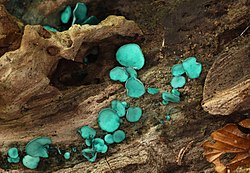| Chlorociboriaceae | |
|---|---|
 | |
| Chlorociboria sp. | |
| Scientific classification | |
| Kingdom: | Fungi |
| Division: | Ascomycota |
| Class: | Leotiomycetes |
| Order: | Helotiales |
| Family: | Chlorociboriaceae Baral & P.R.Johnst. (2015) |
| Type genus | |
| Chlorociboria | |
| Genera | |
The Chlorociboriaceae are a family of "cup fungi" in the order Helotiales, with type genus Chlorociboria . A second genus Brahmaculus, which occurs only in the southern hemisphere (including Chile, New Zealand and Australia), was added in 2021. [1]